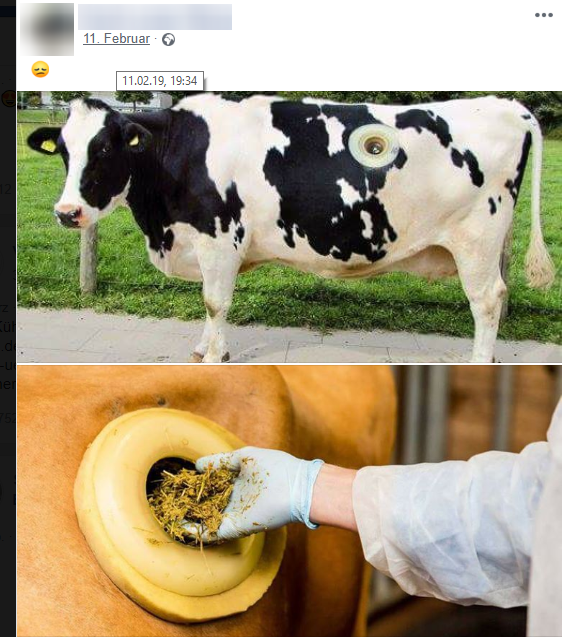The answer is: these cows are fistulated – but what exactly does that mean?
We received a few inquiries about a status post on Facebook that shows two pictures of cows. They wear a kind of ring on their bodies and one of the photos shows that you can apparently “reach through” a hole:

The post creator only posted an emoji as accompanying text and users are now asking what this hole in the cow is all about.
The fact check:
This is a so-called cow fistula or rumen fistula .
Veterinarian Anke Meeuw writes in relation to fistulated cows:
This is about research that serves to reduce global methane emissions.
What all these animals have in common is the forestomach system with the rumen, which is essentially a huge fermentation chamber in which the food is fermented by bacteria. This rumen is particularly important for feeding the animals, because the bacteria that live here enable cows to obtain sufficient energy even under difficult conditions with almost indigestible food (straw, hay, wood, etc.).
[mk_ad]
Not just for research, but also for the animal
The problem: This creates methane, which is a powerful greenhouse gas. One reason for the existence of fistula cows is to research how methane emissions can be minimized through proper feeding while still producing enough milk or meat.
This also makes it much easier and gentler for the animals to research digestion and to clarify many important questions that can be important for environmental protection and nutrition.
Another point is medical help for other animals : During my time at the Hannover University of Veterinary Medicine, we had various fistula animals in the clinics that saved the lives of many of their peers.
Because if a cow, sheep or goat eats too much grain, bread or similar poorly digestible food, the rumen “tips over” like the biological balance in a body of water.
[mk_ad]
All “good” bacteria die and, on the one hand, the cow can no longer process its feed, and on the other hand, it is poisoned by the bacteria that now settle in the rumen and produce alcohol, for example (not good for the cow at all).
The rumen is then usually over-acidic and all the “good” bacteria are dead. In order to save the animal, the rumen is buffered and re-inoculated with rumen fluid from healthy cows, i.e. the necessary bacteria are resettled there. To do this, the rumen juice is withdrawn from healthy cows with fistulas and given to the recipient cow.
Sources:
Notes:
1) This content reflects the current state of affairs at the time of publication. The reproduction of individual images, screenshots, embeds or video sequences serves to discuss the topic. 2) Individual contributions were created through the use of machine assistance and were carefully checked by the Mimikama editorial team before publication. ( Reason )

